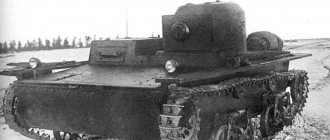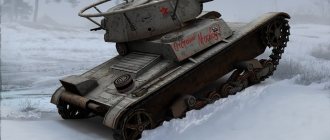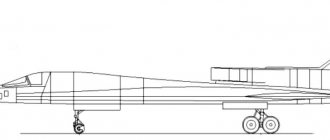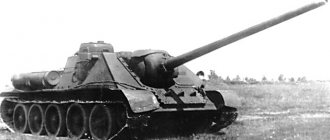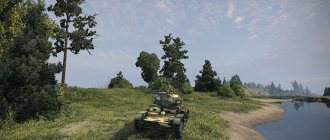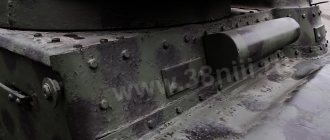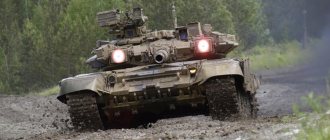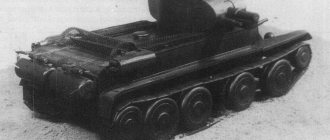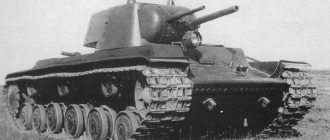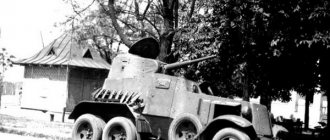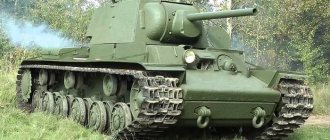Historical information on the IS-3 tank.
The tank began to be developed in the summer of 1944, and the first production model rolled off the assembly line in May 1945 and continued to be produced until mid-1946. Since the tank never had time to take part in hostilities, it became the first post-war Soviet tank.
During the development of this tank, all the shortcomings of the tanks that participated in the Battle of Kursk were taken into account. First of all, attention was paid to the nature of the damage received in the battle by previous generations of tanks. Most of the damage was received to the frontal armor of the hull and turret. As a result, a new streamlined turret and hull shape was developed for the new tank to improve armor performance; the IS-3 became the first tank to receive the so-called “pike nose.”
Like all previous tanks of that time, the IS-3 had a lot of significant shortcomings in the chassis - an unreliable engine and transmission, which was explained by the fact of wartime, the engineers simply did not have time to bring the project to full readiness and reliability. These problems were the reason for the tank's removal from production. Without taking part in hostilities, the IS-3 took part in the parade dedicated to the victory over Nazi Germany, which took place in Berlin.
Booking IS-M
In terms of security, the IS-M wot looks quite decent. The strongest part of the frontal projection is the cast turret: 250 mm, complemented by a gun mantlet.
There are no protruding elements or huge command hatches on the Kolizhen model, so we can safely assume that the tank will be quite confident in tanking with its turret against opponents of any level. The sides and rear of the turret are 140 and 120 mm, respectively, which looks quite decent.
The frontal part of the hull also does not look vulnerable. Here we have a VLD with an armor thickness of 120 millimeters with an armor plate located at a good angle. The thickness of the lower frontal part varies within 150 mm, and in the diamond position it can easily withstand the blows of classmates. The thickness of the side plates is 120 mm, the stern plates are 80.
Technical characteristics of the IS-3 tank in the game.
Let's look at what the tank in the game offers us, nicknamed the “ pike ” for its frontal hull shape. Let's turn to the comparative table of characteristics to immediately see the advantages and disadvantages of our tank compared to rivals of our level.
As you can see, the main advantage of our tank is the power of the gun, as well as fairly good maneuverability and speed. The IS-3 top gun is the most powerful in this class. Another plus is the fairly good level of frontal armor, higher only on the Tiger II, not counting the KV-5.
Green is better, red is worse.
| Characteristics/Tank | IS-3 | KV-5 | Tiger II | VK 4502(P)A | Lowe | AMX 50 100 | T32 |
| Strength | 1450 | 1680 | 1600 | 1470 | 1650 | 1450 | 1400 |
| Weight (t) | 48,68/50,56 | 100,18/105 | 71,32/72,97 | 53,57/54,18 | 92,55/99,85 | 49,1/50 | 54,51/54,83 |
| Engine power (hp) | 650 | 1200 | 870 | 600 | 800 | 575 | 720 |
| Maximum speed (km/h) | 38 | 40 | 28 | 38 | 35 | 51 | 35 |
| Turning speed (deg/sec) | 27 | 18 | 26 | 25 | 24 | 32 | 20 |
| Hull armor (front/sides/stern in mm) | 110/90/60 | 170/150/90 | 150/80/80 | 120/80/80 | 120/80/80 | 90/35/30 | 127/76/51 |
| Turret armor (front/sides/rear in mm) | 150/90/80 | 180/150/140 | 185/80/80 | 100/80/70 | 120/80/80 | 90/30/30 | 114/76/76 |
| Basic projectile damage | 293-488 | 225-375 | 240-400 | 166-275 | 240-400 | 180-300 | 180-300 |
| Armor penetration with basic projectile (mm) | 131-219 | 125-209 | 169-281 | 99-165 | 176-293 | 128-213 | 128-213 |
| Gun rate (rounds/min) | 4,65 | 8 | 6 | 10,53 | 5,71 | 8 | 9,01 |
| Turret rotation speed (deg/sec) | 32 | 22 | 28 | 34 | 26 | 36 | 30 |
| Review (m) | 380 | 400 | 460 | 460 | 460 | 420 | 430 |
| Communication range (m) | 500 | 500 | 810 | 470 | 810 | 450 | 450 |
IS-3 with MZ: grandfather, but not the same one
At the turn of 2015 and 2016 – from December 25 to January 7 – a new premium Soviet IS-3 tank with MZ was available in the Premium Store. This vehicle immediately attracted attention with its name and appearance (after all, the upgradeable IS-3 is one of the most popular and famous tanks in the game, it enjoys well-deserved fame among players, and WG often uses it as one of the WoT symbols), however, very soon the players began to express dissatisfaction. It just so happened that the new tank turned out to be not the usual “grandfather” in the new “packaging”, but something completely different. We also couldn’t ignore this premium tank, we tested it quite a lot in battles, and now we hasten to share our opinion with you.
What is IS-3 with MZ?
IS-3 with MZ is a premium heavy tank of Tier VIII of the USSR development tree. The vehicle was created on the basis of a project developed in the mid-50s of the last century by students of the Academy of Armored Forces. In reality, the tank did not go beyond the preliminary design, but the developers of our game thought that this project was a great idea for a new Soviet premium. We will try to find out how successful this idea was in this review by looking at the main characteristics, advantages and disadvantages of the tank.
Firepower
Unfortunately, the tank does not have the legendary BL-9, but actually a stock gun for the IS-3, which has been modernized. Namely, on the IS-3 with MZ we meet the good old “destructor” D-25TA, which has the following characteristics: Basic penetration - 221/270/61 mm, respectively, with armor-piercing sub-caliber, cumulative and high-explosive fragmentation shells; Average one-time damage – 390/390/530 points, respectively, with BP, KS and HE shells; Reload time – 11.7 s; DPM – 2000 points per minute; Accuracy – 0.46 m/100 m (when turning – 1.62); Mixing time – 3.4 s; Vertical aiming angles – from -5 to +19 degrees; Ammunition - 28 shots.
So, the first thing we see is an atypical set of shells for Soviet “destructors”. The main ammunition used is a sub-caliber projectile with a penetration of 221 mm and the usual damage of 390 points, which flies at a speed of 1400 m/s (which is just excellent), and as a premium one - a cumulative one with a penetration of 270 mm. In principle, this is close to the performance of the top gun of the conventional IS-3, however, it must be taken into account that the normalization of the AP projectile is worse than that of the AP projectile, and the CS requires proper use due to its absorption by screens and various obstacles.
Particularly noteworthy is the combination of low accuracy and long convergence times. There is no question of any comfortable firing here - even the presence of special equipment, crew perks and additional rations cannot reduce the aiming time below 2.6 s, but even in this case, the final accuracy of 0.4 prevents the full implementation of the already low DPM.
In general, the IS-3 with MZ cannot boast of outstanding firepower; its weapon is not an advantage, but rather a problem that the player has to fight with in every battle.
Armor protection
In terms of armor protection, the IS-3 with MZ does not present any surprises - it is a one-to-one upgradeable IS-3. The numbers show the following: Hull armor – 110/90/60 mm in the frontal projection, along the sides and in the stern; The turret armor is 249/172/100 mm in the frontal projection, along the sides and in the stern.
Here we have the same “pike nose” with decent reduced armor (197 mm in NLD, 202 mm in VLD and 239 mm on VLD in places where spare tracks are attached), familiar shielded sides 30 mm thick and large tracks capable of absorbing both conventional and cumulative and HE shells. The same applies to the turret - there is armor in the gun mantlet, and it is significant (in some places it exceeds 300 mm), but on the sides and in the stern the protection is weaker, it can only cope with low-level enemies. Well, the 20 mm turret roof has not gone away, which can be penetrated without ricochets by shells with a caliber of 60 mm or more (in accordance with the three-caliber rule).
In general, the tank seems to have armor, but it doesn’t always make a difference, unless it gets to the top of the list. And the presence of a “pike nose” and shielded sides entails problems and tanking features known to owners of the IS-3: when meeting the enemy head-on, it is not recommended to make a diamond formation (since in this case the reduced armor in one of the halves of the VLD is reduced - sometimes it is worth resorting to to the reverse diamond), and when meeting some opponents it is better to stand on the side (which increases the likelihood of the projectile being absorbed by the screen or track).
Dynamics and agility
We are used to the fact that the IS-3 is a fairly fast tank that does not cause discomfort when moving around the map. And it would be logical to get something similar when purchasing an IS-3 with MZ. But it was not there! Everything will become clear when you get acquainted with the characteristics: Weight/maximum weight of the tank - 49/53.56 tons; Engine power – 520 hp; Specific power – 10.61 hp/t; Maximum forward speed – 40 km/h; Maximum reverse speed – 15 km/h; Chassis rotation speed – 27.1 degrees/s; Turret rotation speed – 22.9 degrees/s; Soil resistance is 1/1.2/2.1, respectively, good, average and bad.
Here we immediately see that the IS-3 with MZ is not just a stock IS-3, but even worse. After all, on a tank being pumped up, a 650 hp engine is installed as a stock one, but here it is only 520 hp! All this results in a significant reduction in mobility - we have only 10.61 hp/t, while the power-to-weight ratio of a conventional IS-3 reaches 14.26 hp. (and even in stock it is 13.23 hp/t).
As a result, we have a tank with poor mobility - it feels like it doesn’t want to move at all, barely picks up speed and always moves among those lagging behind. The tank reaches its declared maximum speed only from a hill, and in a straight line it travels no faster than 35 - 36 km/h (and only on flat roads on city maps it accelerates to 39 km/h).
In fact, the IS-3 with MZ has the worst power supply among all premium Tier VIII heavy tanks, and among the upgradeable tanks it is second only to the heavyweights KV-4, O-Ho and VK 100.01 (P). True, in terms of maximum speed there are worse tanks (for example, the American T32 and some others), but even they accelerate and turn better than the hero of today's review. And how to live with this is completely unclear.
Crew
At the first mention of the IS-3 with MZ, many players decided that the “loading mechanism” in the tank’s name indicated the presence of a drum automatic loader. But this turned out to be a mistake - in fact, this very loading mechanism simply automated the process of loading the gun, making human presence unnecessary (in fact, real developments pursued precisely this goal). The implementation of this mechanism in the game was reduced only to reducing the crew to three members: the Commander (he also performs the functions of a radio operator and loader); Gunner (aka second loader); Driver mechanic.
That is, on the IS-3 with MZ there is simply no separate loader. However, the game mechanics of WoT are such that the tank cannot be missing any of the crew's essences; they are all distributed among the existing members. However, in the case of this premium tank, the situation is quite strange - the functions of the loader are transferred not to one, but to two crew members at once. So one cannot expect that the IS-3 with MZ is completely immune from increased reload time when the loader is wounded, since it is not there. On the contrary, this probability is much higher on a tank than on other similar vehicles, because there are two loaders here.
This situation does not allow the IS-3 with MZ to fully implement the functions of a premium tank for accelerated crew upgrades. Indeed, only three can be transferred to this tank from the same IS-3, and the loader will not be fully upgraded. In the presence of other Soviet premium TTs, this problem is leveled out, but the sediment, as they say, remains.
Overview and camouflage
The visibility of the IS-3 with the MZ is as expected as bad - 350 meters, familiar to us from Soviet heavy aircraft. By installing optics, it increases to 385 meters, and with the appropriate crew perks - up to 413 meters. The maximum visibility on the vehicle can be 439 meters (with ventilation installed and additional rations available) - in most cases this is still not enough to confidently detect enemies.
We won’t talk much about camouflage - this is a typical heavy tank with camouflage of 6.84, it can be increased with camouflage to 8.84 and the corresponding perk to 15.445. However, such indicators will not help the tank to confidently hide from watchful opponents.
Economy
The IS-3 with MZ has a typical economy for premium tanks: for an average victorious battle with 2000 - 2500 damage points you can get 60 - 80 thousand net credits (but only with a premium account), and in case of a loss even with low damage (up to 900) You can gain 20 – 40 thousand. It’s not for nothing that we talked about such low damage here – quite often battles on a tank end with just such results.
Here we see a paradoxical situation: the tank has good economic potential and could take its rightful place among the main farmers in the Hangar, but realizing this potential is extremely difficult. It is much easier to earn silver on many other regular premium machines, which can be freely purchased in the Premium Store or in the game client. Therefore, there is little point in considering the IS-3 with MZ as the main farming machine.
Equipment and equipment assemblies
As it turned out, making a choice of equipment for the IS-3 with MZ is not so easy. We can unconditionally agree with only one thing - the installation of a Gun Rammer, which allows you to reduce the reload time of a gun to 10.3 s. It also makes sense to install a Vertical Stabilizer, which reduces the dispersion of the gun when the turret is rotated and generally has a positive effect on the efficiency of firing. And with the third slot, there are three possible options: Coated optics – at least slightly increases visibility, allowing you to be not completely blind on the battlefield; Reinforced aiming drives – allows you to slightly reduce the aiming time, which is too long for this tank; Improved ventilation - allows you to improve all characteristics, especially firepower.
When choosing your build, you need to rely on the abilities of your existing crew. If you have perks for vision, you can install Optics, and this will allow you to see further than many single-level TTs. But if you have the Brotherhood of Battle perk, it makes sense to install a fan, which will generally increase the capabilities of the tank. Well, it’s better to combine aiming drives with a fan and with various perks for shooting accuracy, etc.
In terms of equipment, everything here is standard - a first aid kit, a repair kit and a fire extinguisher. The repair kit is used several times in each battle - the tank's ammunition rack very often gets damaged, and it has to be repaired two or three times in one battle. On the other hand, the tank rarely burns, so the fire extinguisher can be replaced with an additional ration (in this case, the final accuracy of the gun will be 0.4 - this is still worse than that of the IS-3 without any equipment at all). True, even in this case the tank will not be guaranteed to “bend” - its characteristics are such that it is simply impossible to radically improve them with equipment and equipment.
How to play?
In terms of gameplay, the IS-3 with MZ differs little from the regular IS-3 - it is best for it to operate in typical positions for TT, hold the defense and push through the flanks. Thanks to the good armor of the tower, you can play for the details of the terrain (and at the same time hope that opponents will not fall into the cardboard roof of the tower), and the structural features of the sides and tracks can be confidently diamond-shaped and tanked with the side.
Insufficient visibility of the tank forces you to play from someone else’s backlight, which can negatively affect the final stage of the battle, when there are no more “fireflies” in the allied team. For the same reason, you should not act alone on the flank - the very first light can lead to death from opponents who fire with impunity from invisibility.
The tank's gun requires special attention. It is characterized by poor accuracy and long aiming times, so shooting should only be carried out when the scattering circle is fully compressed. Low accuracy also does not allow you to play from a distance, so the IS-3 with MZ is a typical melee tank.
Fast-flying sabots allow you to take minimal lead (or shoot without it at all), but you must take into account the slope of the enemy tank's armor - poor normalization of AP shells often leads to their ricochet in situations where a regular AP shell would penetrate. And cumulative gold is easily absorbed by various kinds of obstacles, tracks and screens, so it needs to be fired at open areas of enemy armor. Although experienced players already know this very well.
It is also necessary to take into account the dynamics of the vehicle: it does not allow you to quickly take up positions, catch up with those running away and, on the contrary, run away from those who are catching up, and there is no talk at all about returning to base to shoot down a capture. This is a typical “one-flank tank”, the success of the game on which largely depends on the correct choice of this very flank.
In general, the IS-3 with MZ plays the role of a Soviet heavy tank familiar to most players with an oblique gun and strange (more precisely, random, completely unpredictable) armor, which is best implemented as part of attacking or defending groups. And you can’t really come up with anything new here.
What's the result?
So, what did we get in the form of the IS-3 with MZ? Unfortunately, it’s not at all what they expected - it’s far from being an IS-3, but just a pathetic parody of it. Yes, both vehicles have exactly the same armor, but the premium tank has worse firepower and dynamics parameters. He doesn’t really drive and shoots poorly, which often results in low post-battle statistics and negatively affects the player’s statistics as a whole.
There is no need to talk about any kind of balance - unlike many new premiums, the IS-3 with MZ was nerfed, although initially it had good potential. He is only good if he gets into the clear top, when he fights against tanks of levels VI – VII. However, today the balancer works in such a way that the tank very often ends up in Tier X battles, where it is capable of little.
In general, the IS-3 with MZ is a vivid illustration of the old principle “Premium tanks should be worse than their pumped-up counterparts,” which, fortunately, has been canceled today (at least, most new vehicles do not comply with this principle). According to subjective feelings, the IS-3 with MZ is worse than most premium and upgradeable Tier VIII TTs, and playing it does not bring any particular pleasure. It’s funny that Murazor himself spoke about this at one time, but there is no hope for correcting the situation yet (or we simply do not have information about a possible rebalance of the machine).
These considerations are confirmed by statistical data. The average win rate on a tank today hovers around 49.75%, and this level has remained virtually unchanged recently (while the win rate of the regular IS-3 is 49%). Experienced players can maintain a 64-67% win rate on a tank, but for the most part, IS-3 owners with MZ do not show outstanding results and ride the tank quite rarely. Of course, why roll out a car that only evokes negative emotions.
Win percentage
Tank curves
To buy or not to buy?
Summing up all of the above, we can confidently say: the IS-3 with MZ is a dubious purchase for any player, regardless of his experience, level of play and preferences. Perhaps this tank is of interest only to collectors and to players who have set themselves the goal of showing the best results on all the vehicles present in the game. And if you love the IS-3 and Soviet heavy tanks in general, then it’s better to refuse the purchase - the IS-3 with a loading mechanism will disappoint you in the first battle. At first glance, it may seem that the gameplay of this tank is similar to the gameplay of “classic” premiums like Lowe and T34, but in reality both of these tanks are more pleasant and comfortable (and most importantly, stable) than the IS-3 with MZ. So it’s better for lovers of these cars to also spend their money on something more interesting.
Surely, WG also understands that this tank turned out to be quite strange and is not popular among players, so it puts it on sale extremely rarely (even less often than the KV-5, vehicles from the Berlin Four and other unique equipment).
And if, when the IS-3 with MZ appears in the Premium Store, you have the idea of buying it, think a hundred times before giving up your hard-earned money. Author of the article Anton Malyutin
Guide and tactics for playing the IS-3.
As we already said in the analysis of the table, the main trump card of the IS-3 is its powerful cannon. Having played with this tank, you can see that the “pike nose” shape in the frontal part has a fairly high percentage of ricochets. True, the tank can penetrate well under it, but the main thing is not to stand still and not allow it to be targeted.
At the beginning of the battle, we determine the course of action, which primarily depends on our placement in the team: if we are at the very top of the team, our job is to attack on the flank, if below, then we will rather act as cover for stronger brothers in arms.
Unlike other tanks, our gun is more powerful, but not as accurate, so when shooting from long distances, it is advisable to focus completely on the target. Up close this is no longer so important. We conduct fights in a standard way, that is, we try to expose our forehead, of course at an angle . The problem is the fact that under the pike’s nose we have a penetration point, so it is advisable to keep the body moving, or even go behind some kind of cover while reloading.
We fight enemy heavy tanks according to this scheme: we keep our noses towards them and don’t let them come from behind, since the armor there is a little worse. Since we have several penetration points in front, it is better to get close to some enemies, then it will be difficult to penetrate the main point under the nose. We rotate the turret, making it more difficult to break through another point, and this is the hatch on the turret. In principle, in some cases, by “getting used to” the side of the enemy, we can gain an advantage - our tank is quite low and has a streamlined hull shape, there is a chance that the enemy’s shot will ricochet and can work against taller opponents.
If possible, choose a recess for the position so that only the tower is visible. Our tank is low, so even a small recess is enough to hide the hull, which is easiest to penetrate.
There shouldn’t be any special problems with the ST, our turret rotates quite quickly, just like the hull makes turns, and the powerful gun should discourage the ST from trying to spin us around.
From PT according to the situation. There is an opportunity - we press ourselves against the side and shoot, but it’s better not to go head-on, if the enemy is experienced, he will easily shoot us at the right points. And don’t expose your sides and ass to the PTs - they will shoot you and punish you very painfully!
IS-M: performance characteristics
Let's start with the fact that the IS-M has a quite decent safety margin of 1,500 units, and an extremely uncomfortable visibility of 350 meters. Of course, the ability to expose an enemy is not a priority for a heavy vehicle, but even taking this feature into account, the developers clearly deprived the vehicle of farsightedness.
IS-M - level 8 TT branch of the USSR
The weight of the vehicle is 55 tons, which negatively affects dynamics and mobility. In addition, the colossus is driven by a 750-horsepower engine, which allows it to accelerate to 35 km/h.
It is quite expected that the vehicle turned out to be extremely clumsy, but it has a completely acceptable stealth coefficient of 11% for a stationary vehicle. This value does not reach the camouflage indicators of tank destroyers, but compared to most of its classmates it looks quite decent.
As a top-end weapon, players are offered the 122-mm D-25BM gun, with an armor-piercing index of 212 mm. By loading the Golda, the value can be increased to 240 millimeters and quite confidently distribute weighty slaps in the face even to “tens”.
The one-time damage of 390 units also looks decent, which, however, is already traditional for vehicles in this series. The reload speed is 12 seconds, which, together with the alpha, gives a DPM of about 200o units.
Let us add that the gun takes 3 seconds to assemble and has traditionally poor accuracy: the dispersion is 0.42 per 100 meters. It’s better not to talk about negative declination angles: this parameter was never a strong point of Soviet heavy weapons, and taking into account the rear placement of the turret, the barrel will not lower at all.
Full performance characteristics of IS-M:
Brief conclusion
The IS-M tank is quite interesting and protected, capable of providing decent resistance even to high-level opponents. However, for players who are encountering slipper-class machines for the first time, this technique will cause many unpleasant moments.
The tank will be able to tank quite decently on city maps, maintaining direction and distributing good damage. In open locations, gameplay is usually tied to the terrain, so vehicles will often be exposed to enemy shells, unable to aim normally on hilly terrain.
Let’s add that the front location of the transmission adds a percentage of the probability of engine fire: 120 mm of the upper frontal part is not a serious obstacle for powerful “ten” guns, however, a good angle of inclination always leaves a chance for a ricochet.
Finally, let’s express our disapproval of the clearly mocking viewing radius: 350 meters is considered the worst indicator at the level, and we’ll add that the given characteristics are not approved, so the performance characteristics may change at the time of release.
